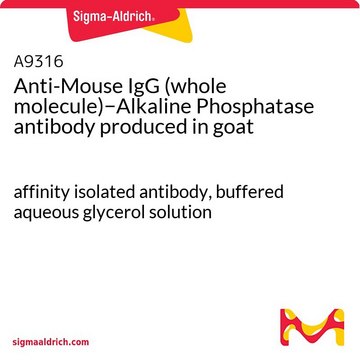Wszystkie zdjęcia(1)
Key Documents
D7679
3,3′-Diaminobenzidine (DAB) Liquid Substrate Dropper System
liquid
Zaloguj sięWyświetlanie cen organizacyjnych i kontraktowych
About This Item
Numer CAS:
Numer WE:
Numer MDL:
Kod UNSPSC:
12352204
Identyfikator substancji w PubChem:
NACRES:
NA.75
Polecane produkty
Postać
liquid
Poziom jakości
metody
immunoblotting: suitable
rozpuszczalność
water: soluble
Warunki transportu
wet ice
temp. przechowywania
2-8°C
ciąg SMILES
Cl.Cl.Cl.Cl.Nc1ccc(cc1N)-c2ccc(N)c(N)c2
InChI
1S/C12H14N4.4ClH/c13-9-3-1-7(5-11(9)15)8-2-4-10(14)12(16)6-8;;;;/h1-6H,13-16H2;4*1H
Klucz InChI
KJDSORYAHBAGPP-UHFFFAOYSA-N
Opis ogólny
DAB (3,3′-Diaminobenzidine Tetrahydrochloride) Liquid Substrate Dropper System has been developed for use in immunohistology and immunoblotting procedures as a precipitating substrate for the detection of peroxidase activity. DAB is the immunohistology substrate of choice because it produces an intense brown stain that is easily observed. The end product is resistant to alcohol, therefore, a variety of counterstains and mounting media can be used with the DAB Liquid Substrate Dropper System. DAB Liquid Substrate Dropper System provides all of the chromogen and buffer/peroxide solutions needed to produce a fast and convenient DAB substrate solution.
Zastosowanie
3,3′-Diaminobenzidine (DAB) Liquid Substrate Dropper System has been used as a developer in immunohistogical examination.
Przestroga
Stable at least one year at 2-8 °C.
Ilość
Each DAB liquid substrate dropper system will provide ten individual application dropper bottles of 10 mL of a fast and convenient DAB substrate solution.
This page may contain text that has been machine translated.
Tylko elementy zestawu
Numer produktu
Opis
- 10× DAB Liquid Chromogen 10 mL
- premeasured, ready-to-use buffer/peroxide solution for individual application 10 x 9
Kod klasy składowania
11 - Combustible Solids
Klasa zagrożenia wodnego (WGK)
WGK 3
Certyfikaty analizy (CoA)
Poszukaj Certyfikaty analizy (CoA), wpisując numer partii/serii produktów. Numery serii i partii można znaleźć na etykiecie produktu po słowach „seria” lub „partia”.
Masz już ten produkt?
Dokumenty związane z niedawno zakupionymi produktami zostały zamieszczone w Bibliotece dokumentów.
Klienci oglądali również te produkty
N M Chu et al.
The journal of histochemistry and cytochemistry : official journal of the Histochemistry Society, 37(2), 257-263 (1989-02-01)
Immunoblotting techniques are widely used for detection of antigen immobilized on nitrocellulose membranes. There are many immunolabeling methods and staining methods available to disclose the presence of antigen in such techniques. Five common staining methods each for alkaline phosphatase and
CD8+ T cells expressing IL-10 are associated with a favourable prognosis in lung cancer
Miotto D, et al.
Lung Cancer, 69(3), 355-360 (2010)
The duality of beta-catenin function: a requirement in lens morphogenesis and signaling suppression of lens fate in periocular ectoderm
Smith AN, et al.
Developmental Biology, 285(2), 477-489 (2005)
Carola W N Damen et al.
Analytical biochemistry, 393(1), 73-79 (2009-06-16)
For the bioanalysis of therapeutic monoclonal antibodies in biological matrices, immunoassays--especially enzyme-linked immunosorbent assays (ELISAs)--are the most widely used techniques. Although ELISAs are very sensitive, the obtained sensitivity is not always sufficient. In this study, we have investigated the possibilities
S M Hsu et al.
The journal of histochemistry and cytochemistry : official journal of the Histochemistry Society, 30(10), 1079-1082 (1982-10-01)
Three metallic ions, NiCl2, CoCl2, and CuSO4, were found to modify the color of the normally brown diaminobenzidine (DAB) reaction. The colors ranged from purplish blue (NiCl2), dark blue/bluish black (CoCl2), to greyish blue (CuSO4). We have found that the
Nasz zespół naukowców ma doświadczenie we wszystkich obszarach badań, w tym w naukach przyrodniczych, materiałoznawstwie, syntezie chemicznej, chromatografii, analityce i wielu innych dziedzinach.
Skontaktuj się z zespołem ds. pomocy technicznej








